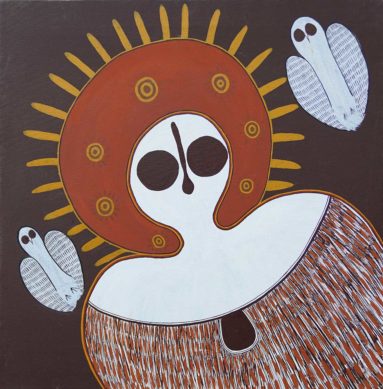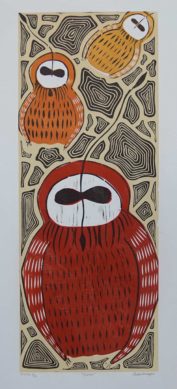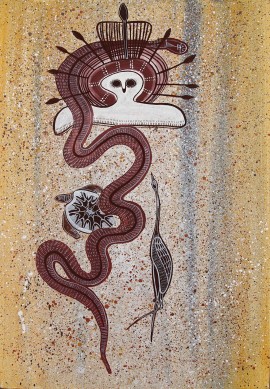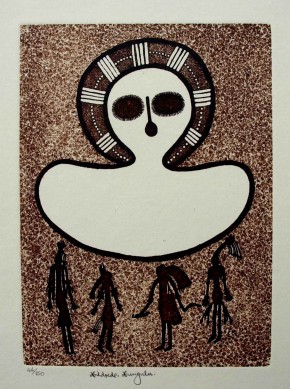Mowanjum Aboriginal Art
A selection of paintings showing the styles from this Aboriginal art region including Wandjina art.
Mowanjum community is located near to the town of Derby, on the southern end of the Gibb River Road in west Kimberley. Mowanjum is home to the Aboriginal people of Worrorra, Ngarinyin, and Wunumbul language groups, who came together early this century at the Kunmunya Presbyterian Mission and the government settlement at Munja. Since 1950, the people have endured many forced moves, first to Wotjulum, then to the old Mowanjum site and finally to the present day Mowanjum located near Derby.
Wandjina
The Worrorra, Ngarinyin and Wunumbul people are the three Wandjina tribes, who view the Wandjinas as the true creators of the land. The Creation and Rain spirit of the Wandjina is represented widely in the Aboriginal rock art sites of the coastal west Kimberley, one of the world’s great ancient art sites.
Traditionally the ochre painted Wandjina sites were repainted each decade, but now only a few sites are maintained in this way. However the tradition behind the ancient rock art continues with contemporary Aboriginal artists painting the symbols of Wandjina and Gyorn Gyorn (Bradshaw figures) on canvas, using ochre materials. With the heritage and generosity of Mowanjum artists, the world has the opportunity to learn more of the oldest and most powerful images in Aboriginal art.
Artists and Exhibitions
Further information for exhibiting Mowanjum artists
Exhibitions including Mowanjum artists and Wandjina art
Mowanjum Paintings and Prints Exhibition 2015
Wandjinas, Ochre and The Art of Mowanjum People
In this interview, Mowanjum artist Leah Umbagai talks about Wandjinas, ochre and the Mowanjum artists with Japingka Gallery, in the lead up to an 2015 exhibition. She is joined by Rosita Holmes who is the Art Development Co-ordinator for Mowanjum Art and Cultural Centre.

Leah Umbagai Wandjina | Jap 12302
The Mowanjum community represents more than one language group. Which groups are those and why were they drawn together?
Leah: There are three tribal groups. They are Worrorra, Ngarinyin and Wunumbal and the tradition of the three tribes is combined under Wandjina which combines the three in shared customs and the law of country. We believe that Wandjina is the creator. He created the country, the people and the land since the beginning when people were first together.
Rosita: The three groups share a kinship system different from other places in the Kimberley.
The work of artists from this area is distinctive in that it represents Wandjinas. Can you describe what this figure means to these artists?
Leah: The people draw about their three different language group areas. Wandjinas are associated with family groups, tribal groups, even people. It doesn’t stop there, it is different in many different ways. It represents different areas. The Wandjinas gave the language, the culture and the laws of the country. They told us how we have to work the country and how we have to live. So all the laws, language and traditions we got from the Wandjinas. This is a very powerful person or spirit being that we believe in. We are here because of the Wandjinas.

Wandjina Artist At Work
Who is allowed to paint Wandjinas?
Leah: The Wandjinas can only be painted by the Ngarinyin, Worrorra and Wunumbal people. We have had people in the past who didn’t know the procedures and protocols for painting Wandjinas. It has really hurt us in the past that people have painted and done all sorts of stuff with Wandjinas. It only belongs to this one area. We were given Wandjina to look after this particular country and it belongs to only the three tribes. Therefore it is only the people who are Ngarinyin, Worrorra or Wunumbal who can paint Wandjinas.
Rosita: Through the hard work of Arts Law and the Kimberley Aboriginal Law and Culture Centre (KALACC) the Wandjina is the first indigenous iconography to be trademarked in Australia. This means that it is now recognised by Australian law to belong to Ngarinyin, Worrorra and Wununbal people. People who are not part of those three language groups are not allowed to use the word or the image of Wandjina without appropriate permission.
Is there an initiation process before artists can paint the Wandjina?
Leah: We have a process that we go through ourselves, those of us associated with the Wandjina and the area we come from. So yes you have to be initiated to be a strong person for that area. People from other places have a different identity. It is very hard for them to understand the whole concept of Wandjinas and how important they are to us. Our people identify with who they are and where they come from. They are Wandjina and they can paint that.
This figure is represented on ancient rock paintings. How far back does the tradition of painting this figure go?
Leah: We believe it comes from the creation time. We believe the Wandjina is the creator of the land, the country and everything that’s in it. This does go beyond our understanding today. There was a time before Wandjina as well. We believe he came from a higher ranking power. Wandjina tells us to take care of the area we belong to.

Wandjina Artist At Work
Mowanjum is referred to as “ochre country”. What is the importance of ochre in this particular exhibition?
Leah: The ochre is very important for our kinship system. Different colours belong to different areas. Red ochre is from one country. The other is a white yellowy ochre that belongs to that particular kinship system. This kinship system gives us our identity as a person. The ochre is very important because it tells of the country. How it was formed, where it is and how it represented on anything – rocks, caves and in contemporary art. This is how we try to express ourselves about where we live now.
Rosita: Mowanjum Arts in-house media team ‘Barnjamedia’ have created a short documentary film about ornmul (ochre) that will be shown alongside the exhibition at Japingka Gallery. This can also be viewed online.
Some of the exhibition works are painted in ochres from the traditional country?
Leah: Yes all of the paintings in the exhibition are in ochre. They tell the story of the artist and their country. They tell of what Wandjina has given to us. We are to have a connection to country and keep strong in ourselves. We have painted with different material in the past. However, using the ochre is more about who we are.
Can you describe the arts centre to me? How many artists work there?
Leah: We’ve got about 120 artists ranging from 3 years old to 90 years old and they come from all different tribal areas. They are male and female. It’s not only artists. We do painting, songs and Junba (dancing). These are all different ways of connecting to the country associated with the ochre. It comes not only in the painting, the dancing, the colours that we use on our bodies, female and male. It plays a major role in everything that we are.
Do any of the artists sing when they are painting?
Leah: Yes mainly the older ones. Now we are encouraging our children to be part of the songs and the dances. You know where you are born into a hierarchy system where you’re not only a dancer or a painter. You have all these different levels of understanding about where you sit especially with tradition. Knowing and keeping up this responsibility, particularly to children or teenagers or adults, it comes connected to who you are and where your ancestors travel or where they belonged. Sometimes you are given dreams. Passing on the traditions in all the different ways you can identify. These are strong areas and you become that person.

Mowanjum Artists | Jap 09010
Is art the major source of employment for people in the Mowanjum community?
Leah: There are all different sorts of revenues that come. Yes at this particular time, art is a big source of income. But art is more than that – it’s about getting people to tell their stories too. In that way, it is not so much a job. It’s more of a giving back to our children, teaching them. It is a teaching process so that they know who they are.
Rosita: 11 of Mowanjum Art and Culture Centre’s 14 employees are from Mowanjum Community. These positions range from trainee’s to full-time senior staff members and include retail, administration, workshop, studio, archive and media assistance. However recent funding cuts mean that we will lose one of these positions every year for the next 6 years.
What do you find exciting about this particular exhibition?
Leah: Knowing that the ochre is from the country and using that. We have to travel a long way to get to our country and the places where we can collect ochre, this hasn’t always been possible in the past. So people came to use whatever they could, like acrylic paint. Now we’ve got ochre again, we can use a more traditional type of painting on the bark, on the wood, on the rock. People used to share, they used to travel. It is exciting to share our art with people outside. We’re giving them a taste of us and where we come from and who we are.

Wandjina & Ungud | Jap 012303
This is an exhibition of emerging artists. can you tell me about that?
Leah: This exhibition has encouraged a lot of people to want to try different mediums. It’s given an opportunity for people to enjoy working and expressing themselves. So the ochre is more than just a medium. I’ve been painting for a very long time and now I’m using ochre I feel more connected because of my kinship to the art and the paint itself. The young artists who are coming up can identify with that and share their stories and the ochre.
The younger ones and the old people have recently had the opportunity to go back to the old country and collect the ornmul (ochre) from there. It means more to us know because we live in a different area now. Going back and gathering the ochre is giving people a reason to go back to their country to live, hunt and to tell stories. Getting the artists the ochre gives them an opportunity to express themselves. The ochre is our identity and it plays a major part of who we are.
Rosita: Some people are combing the traditional techniques with contemporary techniques. Petrina Bedford, Marylou Divillia and many other artists have been using techniques of carving or incising that have been applied for a very long time to rock and wood, pearl shell or boab nut. They are now applying these skills to make woodblock prints. So it is a new technique linked to the long tradition of Mowanjum people and their skills and knowledge of making marks on objects or in the landscape.
There have been several organisations who have directly and indirectly contributed to the making of this exhibition. Country Arts WA provided funding for Petrina Bedford and Edna Dale to come to Fremantle for the exhibition opening. Country Arts WA has also supported the ongoing project ‘Stronger Ground’ that brings together art development, harvesting of materials and language. Batchelor Press, through its Endangered Languages program, works in partnership with the art centre to deliver ‘language of art’ workshops. Ground Up community support network has also provided funding towards the language program.
Read more:




























